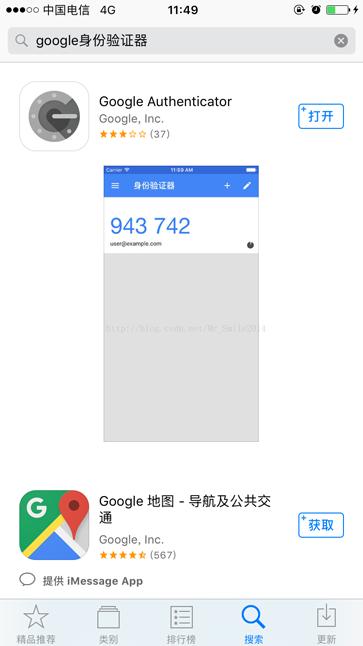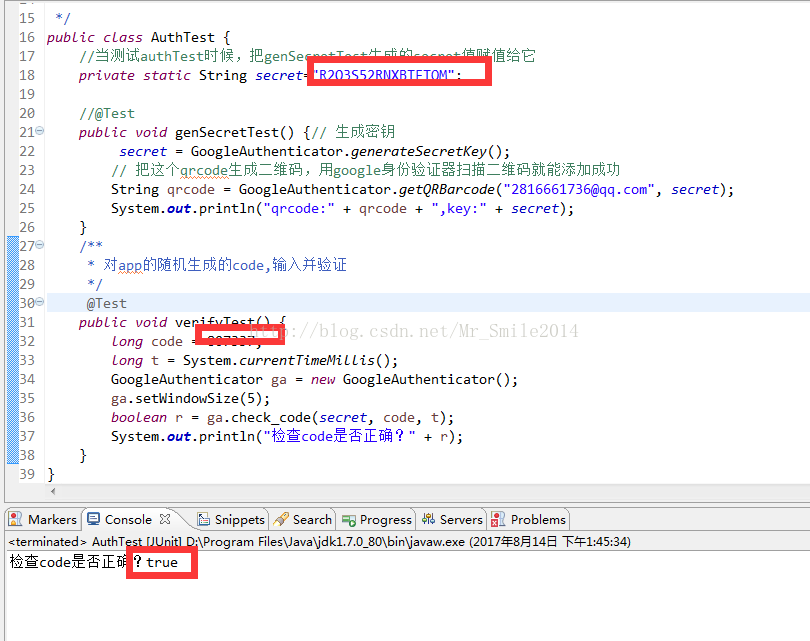最近有用户反应我们现有的短信+邮件验证,不安全及短信条数限制和邮件收验证码比较慢的问题,希望我们也能做一个类似银行动态口令的验证方式。经过对可行性的分析及慎重考虑,可以实现一个这样的功能。
怎么实现呢,是自己开发一个这样的app?这样成本太高了,为了节约成本,我们使用互联网使用比较多的google身份验证器。使用它,我们只需要开发服务端就可以了。
google身份验证器的原理是什么呢?客户端和服务器事先协商好一个密钥K,用于一次性密码的生成过程,此密钥不被任何第三方所知道。此外,客户端和服务器各有一个计数器C,并且事先将计数值同步。进行验证时,客户端对密钥和计数器的组合(K,C)使用HMAC(Hash-based Message Authentication Code)算法计算一次性密码,公式如下:
|
1
|
HOTP(K,C) = Truncate(HMAC-SHA-
1
(K,C))
|
上面采用了HMAC-SHA-1,当然也可以使用HMAC-MD5等。HMAC算法得出的值位数比较多,不方便用户输入,因
此需要截断(Truncate)成为一组不太长十进制数(例如6位)。计算完成之后客户端计数器C计数值加1。用户将这一组十
进制数输入并且提交之后,服务器端同样的计算,并且与用户提交的数值比较,如果相同,则验证通过,服务器端将计数值
C增加1。如果不相同,则验证失败。
|
|
import java.security.InvalidKeyException; import java.security.NoSuchAlgorithmException; import java.security.SecureRandom; import javax.crypto.Mac; import javax.crypto.spec.SecretKeySpec; import org.apache.commons.codec.binary.Base32; import org.apache.commons.codec.binary.Base64; /** * Java Server side class for Google Authenticator's TOTP generator Thanks to * Enrico's blog for the sample code: * * @see http * ://thegreyblog.blogspot.com/2011/12/google-authenticator-using-it-in- * your.htmll * * * @see http://code.google.com/p/google-authenticator * @see http://tools.ietf.org/id/draft-mraihi-totp-timebased-06.txt */ public class GoogleAuthenticator { // taken from Google pam docs - we probably don't need to mess with these public static final int SECRET_SIZE = 10; public static final String SEED = "g8GjEvTbW5oVSV7avLBdwIHqGlUYNzKFI7izOF8GwLDVKs2m0QN7vxRs2im5MDaNCWGmcD2rvcZx"; public static final String RANDOM_NUMBER_ALGORITHM = "SHA1PRNG"; int window_size = 3; // default 3 - max 17 (from google docs) /** * set the windows size. This is an integer value representing the number of * 30 second windows we allow The bigger the window, the more tolerant of * clock skew we are. * * @param s * window size - must be >=1 and <=17. Other values are ignored */ public void setWindowSize(int s) { if (s >= 1 && s <= 17) window_size = s; } /** * Generate a random secret key. This must be saved by the server and * associated with the users account to verify the code displayed by Google * Authenticator. The user must register this secret on their device. * * @return secret key */ public static String generateSecretKey() { SecureRandom sr = null; try { sr = SecureRandom.getInstance(RANDOM_NUMBER_ALGORITHM); sr.setSeed(Base64.decodeBase64(SEED.getBytes())); byte[] buffer = sr.generateSeed(SECRET_SIZE); Base32 codec = new Base32(); byte[] bEncodedKey = codec.encode(buffer); String encodedKey = new String(bEncodedKey); return encodedKey; } catch (NoSuchAlgorithmException e) { // should never occur... configuration error } return null; } /** * Return a URL that generates and displays a QR barcode. The user scans * this bar code with the Google Authenticator application on their * smartphone to register the auth code. They can also manually enter the * secret if desired * * @param user * user id (e.g. fflinstone) * @param host * host or system that the code is for (e.g. myapp.com) * @param secret * the secret that was previously generated for this user * @return the URL for the QR code to scan */ public static String getQRBarcodeURL(String user, String host, String secret) { // String format = // "https://www.google.com/chart?chs=200x200&chld=M%%7C0&cht=qr&chl=otpauth://totp/%s@%s%%3Fsecret%%3D%s"; String format = "otpauth://totp/%s--%s?secret=%s"; return String.format(format, user, host, secret); }// otpauth://totp/OKCoin:[email protected]?secret=LQQZJ6ITK5CKS6YA /** * Check the code entered by the user to see if it is valid * * @param secret * The users secret. * @param code * The code displayed on the users device * @param t * The time in msec (System.currentTimeMillis() for example) * @return */ public boolean check_code(String secret, long code, long timeMsec) { Base32 codec = new Base32(); byte[] decodedKey = codec.decode(secret); // convert unix msec time into a 30 second "window" // this is per the TOTP spec (see the RFC for details) long t = (timeMsec / 1000L) / 30L; // Window is used to check codes generated in the near past. // You can use this value to tune how far you're willing to go. for (int i = -window_size; i <= window_size; ++i) { long hash; try { hash = verify_code(decodedKey, t + i); } catch (Exception e) { // Yes, this is bad form - but // the exceptions thrown would be rare and a static // configuration problem e.printStackTrace(); throw new RuntimeException(e.getMessage()); // return false; } if (hash == code) { return true; } } // The validation code is invalid. return false; } private static int verify_code(byte[] key, long t) throws NoSuchAlgorithmException, InvalidKeyException { byte[] data = new byte[8]; long value = t; for (int i = 8; i-- > 0; value >>>= 8) { data[i] = (byte) value; } SecretKeySpec signKey = new SecretKeySpec(key, "HmacSHA1"); Mac mac = Mac.getInstance("HmacSHA1"); mac.init(signKey); byte[] hash = mac.doFinal(data); int offset = hash[20 - 1] & 0xF; // We're using a long because Java hasn't got unsigned int. long truncatedHash = 0; for (int i = 0; i < 4; ++i) { truncatedHash <<= 8; // We are dealing with signed bytes: // we just keep the first byte. truncatedHash |= (hash[offset + i] & 0xFF); } truncatedHash &= 0x7FFFFFFF; truncatedHash %= 1000000; return (int) truncatedHash; } }
|
测试代码:
/** * 前缀 */ private static String webName = Constant.GoogleAuthName; /** * 注册GOOGLE认证,先传入用户登录名,返回一个MAP,里面有两个KEY,一个是url(value为二维码地址),一个是secret( * 为此用户的地址,此地址用于校验) */ public static Map<String, String> genSecret(String userName) { Map<String, String> map = new HashMap<String, String>(); String secret = GoogleAuthenticator.generateSecretKey(); String url = GoogleAuthenticator.getQRBarcodeURL(webName, userName, secret); // System.out.println("Please register " + url); // System.out.println("Secret key is " + secret); map.put("secret", secret); map.put("url", url); return map; } /** * 校验GOOGLE认证是否成功 */ public static boolean auth(long code, String secret) { long t = System.currentTimeMillis(); GoogleAuthenticator ga = new GoogleAuthenticator(); ga.setWindowSize(5); // should give 5 * 30 seconds of grace... boolean r = ga.check_code(secret, code, t); return true; } /** * 我的 * * @param args */ public static void main(String args[]){ //2JCC26754QEFIPUV boolean res = auth(850161,"2JCC26754QEFIPUV"); System.out.println(res); }
|
具体使用方式(iOS演示):
第一步:进入iphone的appstore,在搜索框中输入google身份验证器,如下图:

选择上图中的google authenticator 并安装。
第二步:运行下面链接中下载的demo中的AuthTest的genSecretTest方法,控制台打印的结果如下图:

key:为app与服务端约定的秘钥,用于双方的认证。
qrcode:是app扫码能够识别的就是二维码值,把它生成二维码如下图:
第三步:打开google authenticator app软件选择扫描条形码按扭打开相机对二维码扫描加入账号,如下图:

第四步:把app中的数字,在AuthTest的verifyTest进行验证,如下图:
通过上面给大家分享了google身份认证器服务端key的生成和它生成的随机密码的验证。


